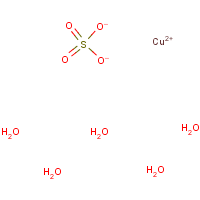Copper sulfate
Agent Name
Copper sulfate
CAS Number
7758-99-8
Formula
O4-S.Cu.5H2-O
Major Category
Metals

Synonyms
Blue Copperas; Blue Vicking; Blue copper AS; Blue vitriol; Bluestone; Calcanthite; Copper sulfate (CuSO4) pentahydrate; Copper sulfate pentahydrate; Copper(2+) sulfate (1:1) pentahydrate; Copper(2+) sulfate pentahydrate; Copper(II) sulfate pentahydrate; Cupric Sulfate; Cupric sulfate pentahydrate; Kupfersulfat-pentahydrat [German]; Kupfervitriol [German]; Roman vitriol; Salzburg vitriol; Sulfuric acid, copper(2+) salt, pentahydrate; Triangle; Vencedor; [ChemIDplus]
Category
Metals, Inorganic Compounds
Description
Large, blue or ultramarine, triclinic crystals or blue granules or light-blue powder; [HSDB]
Sources/Uses
Used as a fungicide and algaecide; [Rosenstock, p. 983] Also used as a mordant in textile dyeing; [www.ci.tucson.az.us/arthazards/medium.html] Used to kill roots invading septic tanks; [Goldfrank, p. 1257]
Comments
Granules or crystals can cause first degree burns on short exposure. [CHRIS] Can cause "vineyard sprayers lung," a form of hypersensitivity pneumonitis that was reported in agricultural workers in Portugal; [Rosenstock, p. 346, 983] "Studies on exposure to copper dust or fumes in industry as a possible cause of chronic lung disease are mostly negative." Fifteen cases of vineyard sprayers lung were reported in 1968-1973 and attributed to inhalation of copper sulfate in "Bordeaux mixture," but the role of copper has not been fully explained. [Nordberg, p. 778] Acute copper poisoning after ingestion can cause liver injury, methemoglobinemia, and hemolytic anemia. Acute renal failure may result, secondary to massive hemoglobinuria. [Goldfrank, p. 1259-60] A severe skin, eye, and respiratory tract irritant; [ICSC] See "Copper."
Reference Link #1
Biomedical References
Exposure Assessment
TLV (ACGIH)
1 mg/m3, as Cu
PEL (OSHA)
1 mg/m3, as Cu
MAK
0.01 mg/m3, respirable fraction (Cu, inorganic cmpnds)
IDLH (NIOSH)
100 mg/m3, as Cu
Adverse Effects
Anemia
Hemolytic anemia
Methemoglobinemia
MetHgb is secondary toxic effect
Hepatotoxin
Hepatoxic (a) from occupational exposure (secondary effect) or (b) in animal studies or in humans after ingestion
Nephrotoxin
Yes
Dermatotoxin
Skin burns
Diseases, Processes, and Activities Linked to This Agent
Processes
Industrial Processes with risk of exposure:
Activities
Activities with risk of exposure: